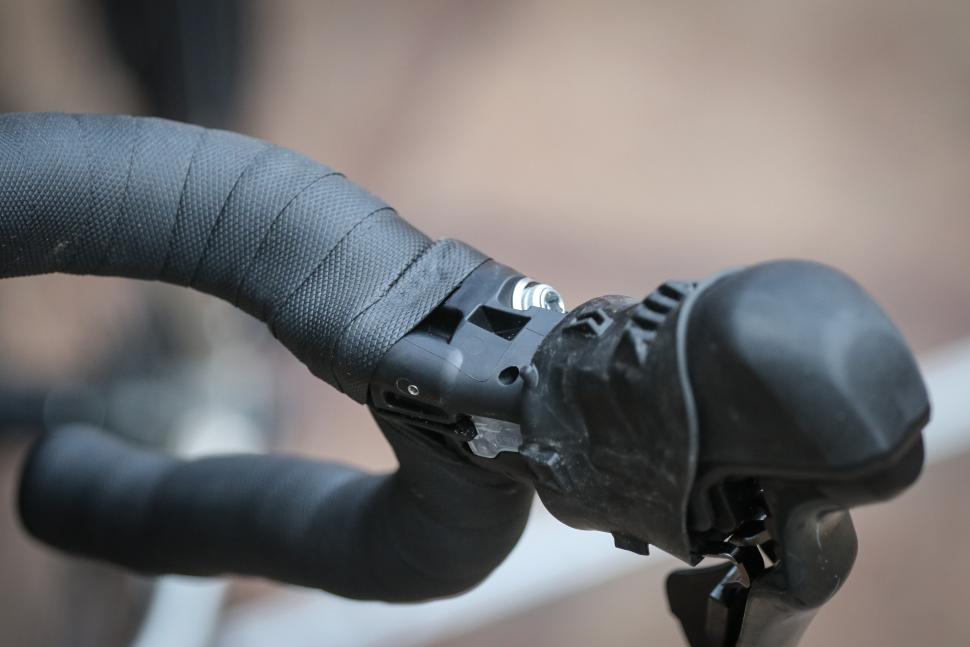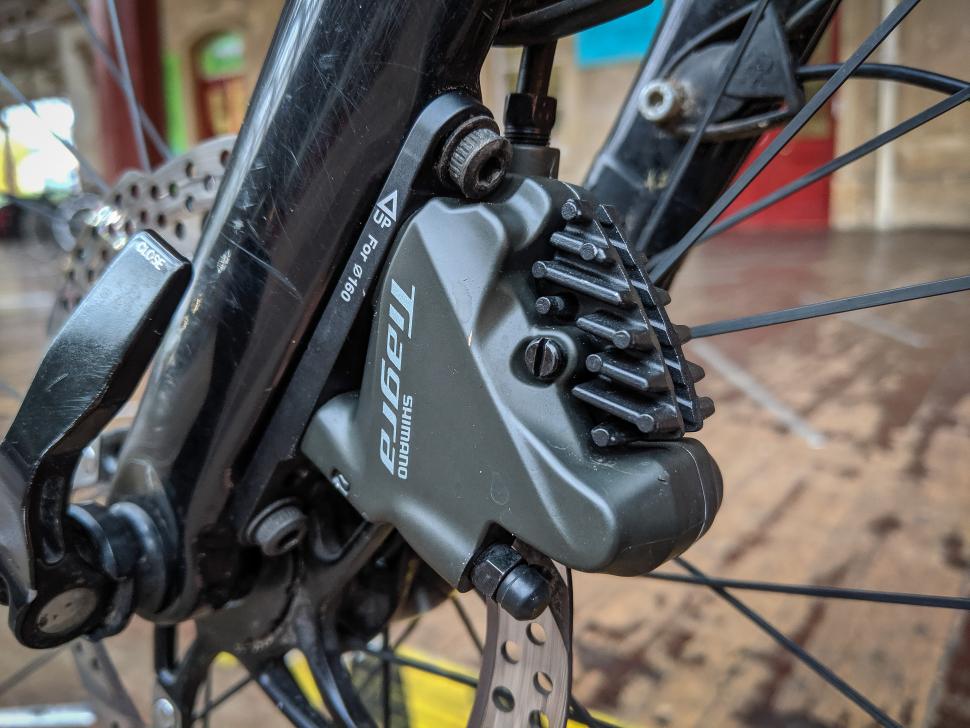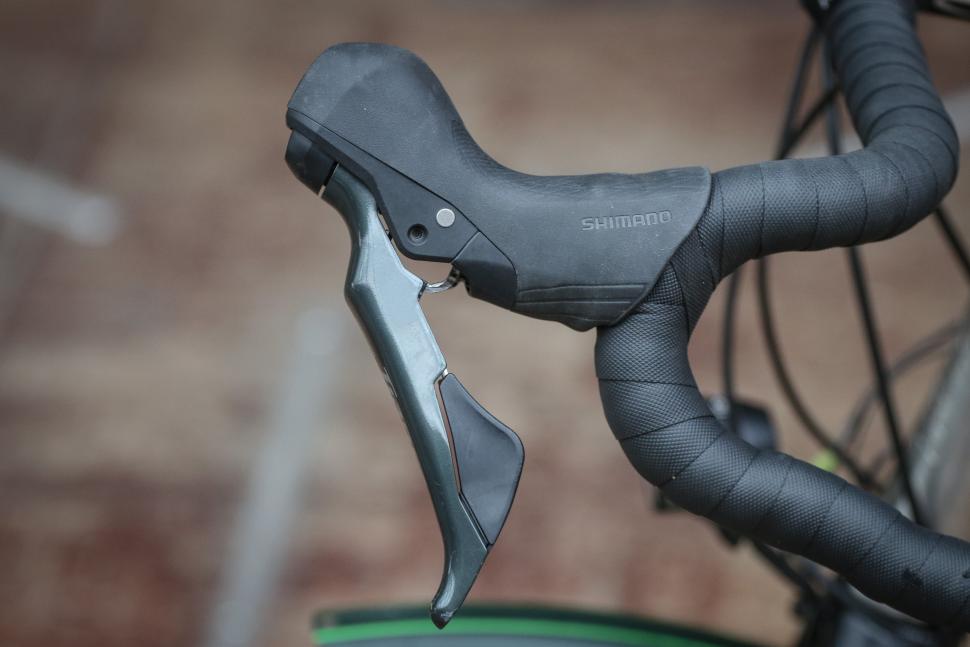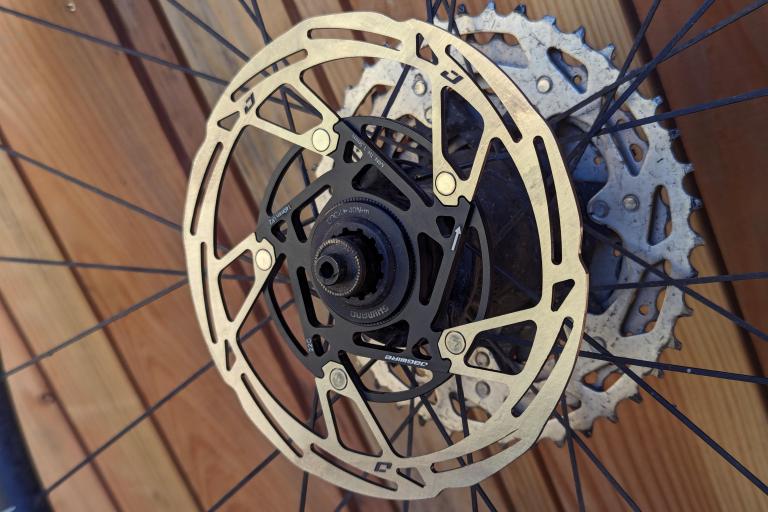- News
- Reviews
- Bikes
- Components
- Bar tape & grips
- Bottom brackets
- Brake & gear cables
- Brake & STI levers
- Brake pads & spares
- Brakes
- Cassettes & freewheels
- Chains
- Chainsets & chainrings
- Derailleurs - front
- Derailleurs - rear
- Forks
- Gear levers & shifters
- Groupsets
- Handlebars & extensions
- Headsets
- Hubs
- Inner tubes
- Pedals
- Quick releases & skewers
- Saddles
- Seatposts
- Stems
- Wheels
- Tyres
- Tubeless valves
- Accessories
- Accessories - misc
- Computer mounts
- Bags
- Bar ends
- Bike bags & cases
- Bottle cages
- Bottles
- Cameras
- Car racks
- Child seats
- Computers
- Glasses
- GPS units
- Helmets
- Lights - front
- Lights - rear
- Lights - sets
- Locks
- Mirrors
- Mudguards
- Racks
- Pumps & CO2 inflators
- Puncture kits
- Reflectives
- Smart watches
- Stands and racks
- Trailers
- Clothing
- Health, fitness and nutrition
- Tools and workshop
- Miscellaneous
- Buyers Guides
- Features
- Forum
- Recommends
- Podcast
review
£439.98
VERDICT:
Great performance for braking and shifting; perfect for your winter bike or commuter
Weight:
0g
Contact:
At road.cc every product is thoroughly tested for as long as it takes to get a proper insight into how well it works. Our reviewers are experienced cyclists that we trust to be objective. While we strive to ensure that opinions expressed are backed up by facts, reviews are by their nature an informed opinion, not a definitive verdict. We don't intentionally try to break anything (except locks) but we do try to look for weak points in any design. The overall score is not just an average of the other scores: it reflects both a product's function and value – with value determined by how a product compares with items of similar spec, quality, and price.
What the road.cc scores meanGood scores are more common than bad, because fortunately good products are more common than bad.
- Exceptional
- Excellent
- Very Good
- Good
- Quite good
- Average
- Not so good
- Poor
- Bad
- Appalling
Shimano's Tiagra Disc levers and callipers are what you should look for on your next commuter or winter bike. They have one less speed than 105 but apart from that you'd be hard pressed to tell the difference without a set of scales. The setup is reasonably easy, and they're light on maintenance and easy to bleed. If you really can't live without 11 speeds at the back they won't be for you, but given the quality of the shifting and the braking, they're a great choice. As an upgrade they're still expensive at full RRP, but you can find them a lot cheaper than that if you shop around.
- Pros: Great braking, accurate shifting
- Cons: Not 11-speed, not compatible with old 10-speed
Our review kit consisted of two ST-4720 levers and two BR-4770 flat mount callipers, for a 2x10 hydraulic disc setup. Setting the system up was simple enough. The hoses come filled with mineral oil and connected to the callipers, and there's an olive ready in the lever which is also full of oil. If you don't need to cut the hose then all you need to do is route the hose, poke a hole in the seal keeping the oil in the hose, and then tighten everything up.
> Find your nearest dealer here
You will need to cut the hose, though, unless you're on a tall bike or something. That means you'll need to dig the insert out of the end of the cut bit, and stick it in the shortened hose. If you heat up the end of the hose with a hair dryer then you can press it in pretty easily.
Once you cut the hose you're in danger of losing some of the oil, but even with pretty extensive faffing with internal routing – which included sticking a bit of sharpened coathanger wire in the end of the hose to guide it through the frame – there was still no real need to bleed the brakes. The bite point was fine and both brakes were about the same. There's no free stroke adjustment on the ST-4720 lever, so you can't adjust the bite point once the system is sealed.
If you do need to bleed the brakes, it's pretty easy. There's an easily accessible cover on the top of the lever that gives you access to the reservoir. You screw an external reservoir into that, and pump mineral oil through the system from the calliper end until all the air is expunged. You need to be careful not to strip off the tiny 2mm hex key head on the reservoir cap, and it's best to remove your wheels to avoid getting oil on the rotors, but the process is straightforward enough.
If you're fitting this lever system as an aftermarket upgrade then the likelihood is that you'll be upgrading from a mechanical setup of some description. And the good news here is that whatever mechanical setup it is, these Tiagra hydraulics will be just miles better.
Shimano, SRAM and Campagnolo all have their champions when it comes to their disc brakes. Personally, I'm happiest with Shimano: they're easy to set up and bleed and they're powerful and reliable, with a host of aftermarket pads available to tune things to your liking. I don't know if we're still talking about whether you need disc brakes on your road bike, or whether you'll be fine with some nice dual pivot rim brakes, or some cantis, or some pressed steel single pivot brakes with cork pads, or rod brakes, or just using your feet on your velocipede. Things move on. Disc brakes are better.
> The stuff they never tell you about disc brakes
These specific disc brakes are very good indeed. There's plenty of power there and they're easy to modulate, and they're exceptional in the kind of filthy conditions that epitomise about half the year's riding round here.
The hood shape has been refined over the last few years and I find it pretty comfortable; there's a small lump where the hose exits the lever and if you hold the handlebar in a certain way that could be an issue, though it wasn't for me.
The levers are easy to use from the hoods and drops, assuming you have nice big hands: I can grab a handful happily enough but I wouldn't want the levers to be much farther from the bar, and I've got hands like shovels. You can adjust the reach inwards, but by doing so you reduce the active stroke of the lever, and because you can't change the bite point you might find yourself running out of room between the lever and the bar if your reach is especially short. For riders with smaller hands there are the ST-4725 levers – they're pretty much exactly the same, just with a smaller lever size and slightly adjusted ergonomics.
The K03S Resin pads on this test set are a bit smoother in feel but don't last as long as the K04S Metal pads, which aren't quite as nice to use in my experience but last a lot longer. Whether the brakes come with resin or metal pads is down to whichever your country's Shimano distributor chooses – in the UK it's resin. If you want metal you'll have to buy them separately. My pad of choice once it comes to renewal time is the SwissStop Disc 34 RS – it doesn't feature cooling fins but I've never really found them necessary for UK conditions.
The pads self-centre very efficiently, so there's no need to constantly fiddle with the setup, although the space between the pads and the rotor is pretty minimal and requires fairly accurate setup in the first instance. If your flat mount is a bit off – and many are – then you might find that they rub and some facing off is required, even if your mechanical discs (where the pads tend to sit further from the rotor) were fine.
Derailleur-wise, the Tiagra system is 10-speed at the back but Shimano, in its infinite and benevolent wisdom, has chosen to change the pull ratio so that the new 4700-series Tiagra isn't compatible with any other 10-speed Shimano road groupset. You can in theory use these levers with an 11-speed derailleur, though, as the pull ratios are the same or near as dammit. Shimano wouldn't recommend that, of course, as it likes you to have everything the same. Life's not always like that though.
I'd been running a Shimano 105 groupset on the bike before this (I'm gradually working my way down the range, it seems) and that was with an 11-34 11-speed cassette. So the Tiagra's 11-34 10-speed cassette offers exactly the same range, and for the first seven sprockets it's exactly the same in terms of sprocket size. After that it ramps up a bit more quickly. I wasn't convinced that I'd notice the difference, but actually I did, especially the jump from 26 to 30 teeth (15%) which feels like a bit of a big step down. It's not the biggest on the cassette – the jump from 11 to 13 teeth at the other end is 18% – but it is the most noticeable, as it always comes at a time when you're working pretty hard up a hill. I stopped noticing after about a month, and now I've adjusted my filter to the bigger jumps. It's really not an issue.
> Your complete guide to Shimano road bike groupsets
Everything else about the shifting is great. The shifts at both ends of the transmission are crisp and accurate, and the lever action is light but positive. It's not as slick as the top-end groupsets, but in terms of actual functionality it's really not far off, which is impressive from a fourth-tier groupset.
Overall, the Tiagra hydraulic disc setup is easy to get on with, and easy to recommend. If you're running a winter bike or an all-purpose machine then it's hard to see how you can do better than this really: you get the ergonomics and most of the performance of the higher-end groupsets in a good value package. You're missing a speed you probably won't notice, and it's heavier than the Gucci groupsets, but that's about it.
Verdict
Great performance for braking and shifting; perfect for your winter bike or commuter
road.cc test report
Make and model: Shimano Tiagra ST-4720 STI & BR-4770 flat mount calliper
Size tested: One
Tell us what the product is for and who it's aimed at. What do the manufacturers say about it? How does that compare to your own feelings about it?
Shimano says, "New 10-speed TIAGRA provides serious entry-level riding performance with cascaded technology from top-tier lines."
Tell us some more about the technical aspects of the product?
From Shimano:
More intuitive control for shifting
The new 10-speed cable pitch for wider frame compatibility
Upgraded with cascaded technology from DURA-ACE
Rate the product for quality of construction:
8/10
Nicely made and easy to fit.
Rate the product for performance:
9/10
Not far off 105/Ultegra in terms of performance.
Rate the product for durability:
8/10
Been running it in filthy conditions for months; all good so far.
Rate the product for weight (if applicable)
6/10
Weight is not really the selling point here. It's not over-heavy though.
Rate the product for comfort (if applicable)
7/10
Hood shape is comfy, braking from hoods and drops is easy.
Rate the product for value:
6/10
Buying aftermarket at RRP it still seems pricey compared to non-disc gear, but as OEM spec on a new bike you're getting a lot for your money.
Tell us how the product performed overall when used for its designed purpose
Near-flawlessly.
Tell us what you particularly liked about the product
Build quality, function, reliability, ease of use.
Tell us what you particularly disliked about the product
Pity there's no bite point adjustment.
Did you enjoy using the product? Yes
Would you consider buying the product? Yes
Would you recommend the product to a friend? Yes
Use this box to explain your overall score
The new Tiagra is really, really good. Most of the time it's functionally indistinguishable from 105, which is hardly any different to Ultegra. For a general purpose bike it's going to be hard to beat.
About the tester
Age: 45
I usually ride: whatever I'm testing... My best bike is: Kinesis Tripster ATR, Merida Scultura
I've been riding for: Over 20 years I ride: Every day I would class myself as: Experienced
I regularly do the following types of riding: road racing, time trialling, cyclo-cross, commuting, touring, club rides, sportives, general fitness riding, fixed/singlespeed, mountain biking, Mountain Bike Bog Snorkelling, track
Dave is a founding father of road.cc, having previously worked on Cycling Plus and What Mountain Bike magazines back in the day. He also writes about e-bikes for our sister publication ebiketips. He's won three mountain bike bog snorkelling World Championships, and races at the back of the third cats.
Latest Comments
- Destroyer666 37 min 5 sec ago
"Can we please stop paying attention to him?"= cancel culture. It does not matter on what side of the fence you are regarding a matter. So please,...
- Rendel Harris 58 min 20 sec ago
I know they're the dregs but that really would be scraping the bottom of the barrel.
- E6toSE3 1 hour 16 min ago
No. New world economics notwithstanding, prices of tech stuff have mostly come down a lot over the decades, sometimes in actual numbers of £s and ...
- Dnnnnnn 1 hour 39 min ago
+1 for the physio. I'd knee problems a few years back - except the problem wasn't really my knees, it was muscles above and below. I doubt I'd have...
- Oldfatgit 2 hours 2 min ago
It's still 'better' than the 6 points and small fine the guy that broke my back [and ulna, and knee, and 11 ribs] got.
- quiff 2 hours 40 min ago
Have a look here - https://road.cc/content/forum/bike-respray-312357
- essexian 2 hours 44 min ago
In what way does he do that? I am sure you won't mind providing information to support your comment. Thanks.
- chrisonabike 3 hours 5 min ago
Just another SUV driver in the Bible there. His conveyance was like a whale - but an earlier traveller had something as roomy as an ark!...
- Disgusted of Tunbridge Wells 3 hours 36 min ago
Kendo (Japanese: 剣道, Hepburn: Kendō, lit. 'sword way' or 'sword path' or 'way of the sword') is a modern Japanese martial art, descended from...















Add new comment
22 comments
I had to use a 2.5mm hex key to open the reservoir cap on my 4725 shifters. Are you sure the 4720's are 2mm?
yeah, it'll only shift the 10 speed cassette properly, in theory you'll get a couple of good shifts using the 4700s with an 11 speed cassette but it'll start getting rougher the further away from the first sprocket you decide is the position 1 (e.g losing the 11T and starting with 12).
As many people know there are some anomoly's that mean you can shift more than adequately across a larger cassette so you can lock out the bottom or top sprocket but with mr.Shimano insisting on changing pull ratios and even fiddling with braking between the groupset changes it's complicated an infuriating at times when all you want to do is say change the shifters or even just get a RD that will accept a bigger sprocket/capacity without changing everything else and not have to make more mods like dropping the effective position of the derailleur hanger and shift mate kit.
Ok - so i'm back where I started So the pull ratio on the RD-4700 mech is different to the 11-speed mechs and the cable pull at the shifters is the same (FAPP) as the 11-speed ones. That matches up with what i'd previously seen, and seems to match up with the Shimano compatibility charts, e.g.
So the pull ratio on the RD-4700 mech is different to the 11-speed mechs and the cable pull at the shifters is the same (FAPP) as the 11-speed ones. That matches up with what i'd previously seen, and seems to match up with the Shimano compatibility charts, e.g.
https://productinfo.shimano.com/#/com/2.4?acid=C-455&cid=C-453
No, the pull ratio on the RD-4700 is the same as other 11 speed road derailuers, it's just the ST-4700 shifter that pulls more cable than the 11 speed shifters to move the derailuer across the wider spaces ten speed cassette.
So if the shifters have greater cable pull, they're working with the 11-speed rear mechs purely because they're 'close enough' to not be completely shite ? (i.e. they're not overshifting enough on the 11-speed cassettes to cause a problem). I used to have a link to an article with tables of all the (at the time current) standard pull ratios and cable pulls for the big 3, still can't find that - if anyone has a similar link, that'd be good, cheers.
They pull more because the cogs on 10sp cassettes are wider apart and so the derailleur need to move more. The compatibilty here is 10sp shifter + 10sp cassette + 11sp derailleur, in which case shifting will be as good as with a 10sp derailleur. You cannot use Tiagra shifters with a 11sp cassette.
Yep, that's a given.
That's exactly what I was getting at - I had assumed that folk talking about using an 11-speed rear mech were also shifting an 11-speed cassette, seemed like a really weird thing to do otherwise, but seems I was mistaken
11-34 10-speed
So widely spaced you have to change gear by post.
Cheers RiderX - I thought the shifters had the same cable pull, and the mech a different pull ratio, hadn't realised it was the other way around.
You can't beat a good old compatibility thread
Shimano are still using those rubbish pad retaining pins!
Anyone who has Shimano hydraulics with the flat-head retaining pins needs to check that the retaining pin doesn't seize. The metal heads are made of a material similar to butter and can shear off when you look at them funny, so either replace them with a similar retaining pin with a hex head or periodically undo them before they seize (a tiny bit of grease may help if you're careful).
I've replaced mine with the retaining pins for the XT-M785 although they are a tiny bit longer.
yeah they're not the finest
This, this, 1000% this!
Either replace or clean regularly. Either way, it's a faff for a 5p quality saving from Shimano.
Been using these levers all summer for thousands of kilometers and find them a joy compared to the old ones. Not sure if I read this review correctly but they are very much compatible with old tiagra (at least on my bike) except for the brake hose connectors which are new but can be replaced. At one point I got the lever hood snagged in transport and needed to replace it. After some detective work my local bike shop figured out it now uses the same lever hoods as Shimano 105. All in all very happy with the upgrade.
So: this is my understanding. The 4700 levers use the same cable pull as the newer 11-speed levers in the range above them. that means that the 4700 rear derailleur has been redesigned, with a different pull ratio, and the *only* 10-speed derailleur the 4700 levers will work properly with is the matching one from the groupset. the 4600 one and all older 10-speed mechs are technically incompatible.
because the cable pull is the same as all the 11-speed groupsets, you can *also* use an 11-speed cassette and 11-speed derailleur and that'll work fine too, with the obvious proviso that you can only use 10 of the 11 sprockets.
Of course, what Shimano *says* is incompatible and what is *actually* incompatible in real world conditions are two different things
I think you'll find it is the shifters that are an island of incompatability.
The 'new' Tiagra derailleur works with otherwise 11 speed setups (i.e. straight swap for 105, ultegra etc).
The 'new' Tiagra 10 speed shifters aren't comnpatable with old 8/9/10 speed derailleurs. The amount of cable pull is different to old 10 speed but also different to 11 speed too.
I presume the10 speed GRX shifters are the same based on the compatability charts.
There is another dimension to this with MTB component compatability and front shifter compatability too.
I thought I knew the compatibility bits for this but i'm proper confused now, knew it was incompatible with older 10-speed and (at least partially) compatible with 11-speed - that looks like although the cable pull with the new Tiagra shifters is different to Shimano 11-speed, they work as a straight swap with those groupsets despite that different pull ... have I got that right from what you're saying ?
My 4700 levers work perfectly fine with 5800 & R7000 mechs, with no particular faff to get them working cleanly.
Agreed, here too, I'd read it on another forum a couple of years ago when it (4700) first came out from other people trying that and indeed a contact within Shimano confirmed the compatibility. The internals of the 4700 are the same as 5800 apparently.
The rear mech can be any of the 11 speed offerings but I think the front/left STI is more suited to the 4700/5800/6800 FD type though not unworkable with the later FD design.
Mind it did take more setting up/trimming to get it right which I wrote off as new cables stretching but its actually performing better than the previous setup which had the occasional problem.
Dave, I think you have a couple things backwards.
It is true that the 4700 rear derailleur has the same pull ratio as the 11-speed rear derailleurs, meaning you could swap in a 105 11-speed derailleur, or a 4700 rear derailleur to an otherwise 11-speed setup. But, everything else must not change (i.e., a 4700 setup would need a 10-speed chain and cassette; a 11-speed setup would need an 11-speed cassette and chain). You cannot run an 11-speed cassette on a 4700 system, due to different amount of cable pull from the perspective shifter.
When you click a 10-speed 4700 shifter it will pull a different amount of cable, than one click on an the 11-speed shifters, otherwise the derailleur wouldn't line up with the cassette cogs ( spacing is 2.35mm for 10-speed to 2.18mm for 11 speed cassette). The 4700 and 11-speed rear derailleurs move the same amount for a given amount of cable pull, therefore you need to pull different amounts of cable at the shifter to match the shifting pitch of the perspective cassettes.
The most helpful comment in this thread. Thanks Road.cc for leaving these comments viewable. Really useful info here.